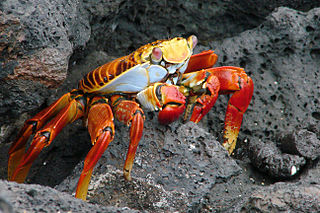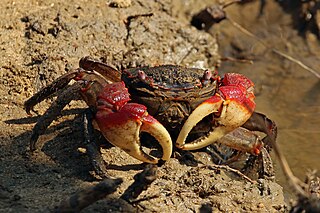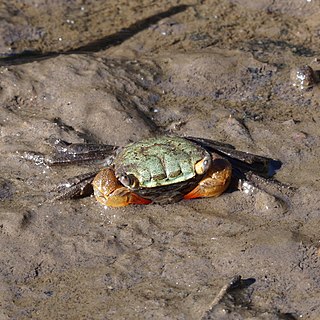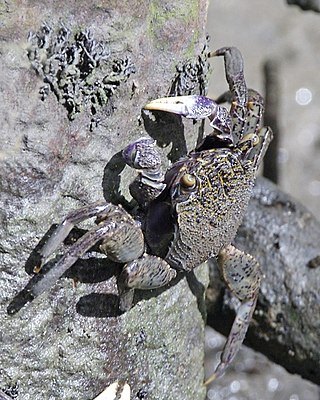Related Research Articles

The fiddler crab or calling crab may be any of more than one hundred species of semiterrestrial marine crabs in the family Ocypodidae, well known for their sexually dimorphic claws; the males' major claw is much larger than the minor claw, while the females' claws are both the same size. A smaller number of ghost crab and mangrove crab species are also found in the family Ocypodidae. This entire group is composed of small crabs, the largest being slightly over two inches (5 cm) across. Fiddler crabs are found along sea beaches and brackish intertidal mud flats, lagoons, swamps, and various other types of brackish or salt-water wetlands.

The Grapsidae are a family of crabs known variously as marsh crabs, shore crabs, or talon crabs. The family has not been confirmed to form a monophyletic group and some taxa may belong in other families. They are found along the shore among rocks, in estuaries, marshes, and in some cases pelagic among drifting seaweeds and flotsam.

The Grapsoidea are a superfamily of crabs; they are well known and contain many taxa which are terrestrial (land-living), semiterrestrial, or limnic. Another well-known member with a more conventional lifestyle is the Chinese mitten crab, Eriocheir sinensis.

Perisesarma is a genus of mangrove crabs in the family Sesarmidae predominantly found in the Indo-Pacific. Some 23 species are described as of late 2006, with two from West Africa: P. kammermani(De Man, 1883) and P. albertiRathbun, 1921. They are typically small, semiterrestrial crabs found on the forest floor at low tide. They eat nearly anything they can, and try to eat anything that does not threaten them — including pencils and other objects dropped on the forest floor. The last species of the genus described is P. samawatiGillikin and Schubart (2004). It can be found in East Africa along with P. guttatum, but its sister species is P. eumolpe from Malaysian mangroves.

The Gecarcinidae, the land crabs, are a family of true crabs that are adapted for terrestrial existence. Similar to all other crabs, land crabs possess a series of gills. In addition, the part of the carapace covering the gills is inflated and equipped with blood vessels. These organs extract oxygen from the air, analogous to the vertebrate lungs. Adult land crabs are terrestrial, but visit the sea periodically, where they breed and their larvae develop. Land crabs are tropical omnivores which sometimes cause considerable damage to crops. Most land crabs have one of their claws larger than the other.

The Sesarmidae are a family of crabs, previously included in the Grapsidae by many authors. Several species, namely in Geosesarma, Metopaulias, and Sesarma, are true terrestrial crabs. They do not need to return to the sea even for breeding.

Parasesarma erythrodactyla, also known as the red-handed shore crab, is a burrowing crab inhabiting mangrove forests in Australia and Southeast Asia. It is immediately identifiable by its bright red chelipeds (claws) and green/brown carapace.

The Varunidae are a family of thoracotrematan crabs. The delimitation of this family, part of the taxonomically confusing Grapsoidea, is undergoing revision. For a long time, they were placed at the rank of subfamily in the Grapsidae, but they appear to be closest to Macropthalmus and the Mictyridae, which are usually placed in the Ocypodoidea. It may thus be better to merge the latter superfamily with the Grapsoidea, retaining the latter name as it is older.

Austruca perplexa is a species of fiddler crab. It is found from the Ryukyu Islands, Japan to India, throughout the Malay Archipelago, along eastern Australian coasts from Queensland to New South Wales, and in various Pacific islands, including Fiji, Tonga and Vanuatu.

Dyspanopeus sayi is a species of mud crab that is native to the Atlantic coast of North America. It has also become established outside its native range, living in Swansea Docks since 1960, the Mediterranean Sea since the 1970s, the North Sea since 2007 and the Black Sea since 2010. It can reach a carapace width of 20 mm (0.8 in), and has black tips to its unequal claws. It feeds on bivalves and barnacles, and is in turn eaten by predators including the Atlantic blue crab, Callinectes sapidus. Eggs are produced from spring to autumn, the offspring reach sexual maturity the following summer, and individuals can live for up to two years. The closest relative of D. sayi is D. texanus, which lives in the Gulf of Mexico; the two species differ in subtle features of the genitalia and the last pair of walking legs.

Parasesarma leptosoma, also known as the arboreal crab, is an arboreal, leaf-eating mangrove crab, from East and South Africa where it is found on Rhizophora mucronata and Bruguiera gymnorhiza, but not on Avicennia marina. It occupies an ecological niche similar to that of another sesarmid, Aratus pisonii, from the Americas.

Geosesarma dennerle is a species of small land-living crabs found on Java, Indonesia.

The violet vinegar crab is a swimming crab species in the genus Episesarma. Distributed all over marine and brackish waters of Indo-West Pacific regions. It is harvested by many local fishermen for rich proteinaceous food.

The Micro Mangrove Crab (Haberma tingkok) is a species of micro-mangrove crab native to Hong Kong. It was first discovered by Stefano Cannicci from the University of Hong Kong and Peter Ng from the University of Singapore in the Ting Kok Mangrove forests in the northeast of Hong Kong and listed on the World Register of Marine Species (WoRMS) in April 2017. It was the third species placed in the genus Haberma, which was discovered in 2002.

Haberma is genus of small mangrove or terrestrial crabs, typically less than 1 centimetre (0.4 in) across the carapace.

Leptuca thayeri, known generally as the Atlantic mangrove fiddler crab or mangrove fiddler, is a species of true crab in the family Ocypodidae. It is distributed all across the Western Atlantic.
Leptuca speciosa, commonly known as the brilliant fiddler crab or the longfinger fiddler crab, is a species of fiddler crab native to the southern United States, Mexico, and the Caribbean.

Parasesarma messa, commonly known as the maroon mangrove crab, is a species of burrowing crab found in Queensland, Australia. It lives in mangroves in estuaries and sheltered bays. It was originally described as Sesarma messa, but was placed in the genus Parasesarma in 2017. Perisesarma messa is also a synonym.

Aratus is a neotropical genus of tree-climbing mangrove crabs in the serarmid family. The genus was first described by Henri Milne-Edwards in 1853, by separating A. pisonii into its own monotypic genus. Aratus has a range spanning Baja California and Sonora, south to Peru along the east Pacific, and from Florida to Brazil in the west Atlantic. Though there has long been attempts to distinguish the Atlantic and Pacific populations of Aratus into separate taxa, it was not until 2014 that sufficient genetic and morphological evidence was collected for the Pacific population to be described as a distinct species.

Sesarmops is a genus of crabs in the family Sesarmidae. Its members are distributed through the Indo–West-Pacific oceanic region. They live in freshwater forest streams near the coast, and in mangroves.
References
- ↑ "Perisesarma guttatum (A. Milne-Edwards, 1869)". World Register of Marine Species (WoRMS). Retrieved 1 November 2016.
- ↑ "Observations in the Species: Perisesarma guttatum". © The Open University. Retrieved 1 November 2016.
- 1 2 3 4 5 Flores AA, Saraiva J, Paula J (January 2002). "Sexual maturity, reproductive cycles, and juvenile recruitment of Perisesarma guttatum (Brachyura, Sesarmidae) at Ponta Rasa mangrove swamp, Inhaca Island, Mozambique". Journal of Crustacean Biology. 22 (1): 143–156. doi: 10.1163/20021975-99990217 .
- ↑ "Sesarma guttatum Milne-Edwards, 1869". sea life base. Retrieved 1 November 2016.
- ↑ "Perisesarma guttatum (Milne-Edwards, 1869)". sea life base. Retrieved 1 November 2016.
- 1 2 3 4 Shahdadi A, Schubart CD (January 2015). "Evaluating the consistency and taxonomic importance of cheliped and other morphological characters that potentially allow identification of species of the genus Perisesarma De Man, 1895 (Brachyura, Sesarmidae)". Crustaceana. 88 (10–11): 1079–1095. doi:10.1163/15685403-00003473. ISSN 1568-5403.
- ↑ Bowling B (2012). "Crustacean Glossary". Texas Parks and Wildlife Department. Retrieved 24 April 2022.
- 1 2 "Perisesarma guttatum (A. Milne Edwards, 1869)". A field guide to Kenyan mangroves. Retrieved 1 November 2016.
- 1 2 3 4 Amaral V, Penha-Lopes G, Paula J (July 2009). "RNA/DNA ratio of crabs as an indicator of mangrove habitat quality". Aquatic Conservation: Marine and Freshwater Ecosystems. 19 (S1): S56–S62. doi:10.1002/aqc.1039. S2CID 84150126.
- 1 2 3 4 Gillikin DP, Schubart CD (July 2004). "Ecology and systematics of mangrove crabs of the genus Perisesarma (Crustacea: Brachyura: Sesarmidae) from East Africa". Zoological Journal of the Linnean Society. 141 (3): 435–445. doi: 10.1111/j.1096-3642.2004.00125.x .
- 1 2 Fratini S, Ragionieri L, Cannicci S (December 2017). "Correction: Demographic History and Reproductive Output Correlates with Intraspecific Genetic Variation in Seven Species of Indo-Pacific Mangrove Crabs". PLOS ONE. 12 (12): e0189550. Bibcode:2017PLoSO..1289550F. doi: 10.1371/journal.pone.0189550 . PMC 5724817 . PMID 29228041.
- 1 2 Cannicci S, Bartolini F, Dahdouh-Guebas F, Fratini S, Litulo C, Macia A, et al. (September 2009). "Effects of urban wastewater on crab and mollusc assemblages in equatorial and subtropical mangroves of East Africa" (PDF). Estuarine, Coastal and Shelf Science. Marine Science in the Western Indian Ocean Responds to Population Pressures and Climate Change. 84 (3): 305–317. Bibcode:2009ECSS...84..305C. doi:10.1016/j.ecss.2009.04.021. ISSN 0272-7714.
- 1 2 3 Silva IC, Mesquita N, Paula J (January 2010). "Genetic and morphological differentiation of the mangrove crab Perisesarma guttatum (Brachyura: Sesarmidae) along an East African latitudinal gradient". Biological Journal of the Linnean Society. 99 (1): 28–46. doi: 10.1111/j.1095-8312.2009.01338.x .